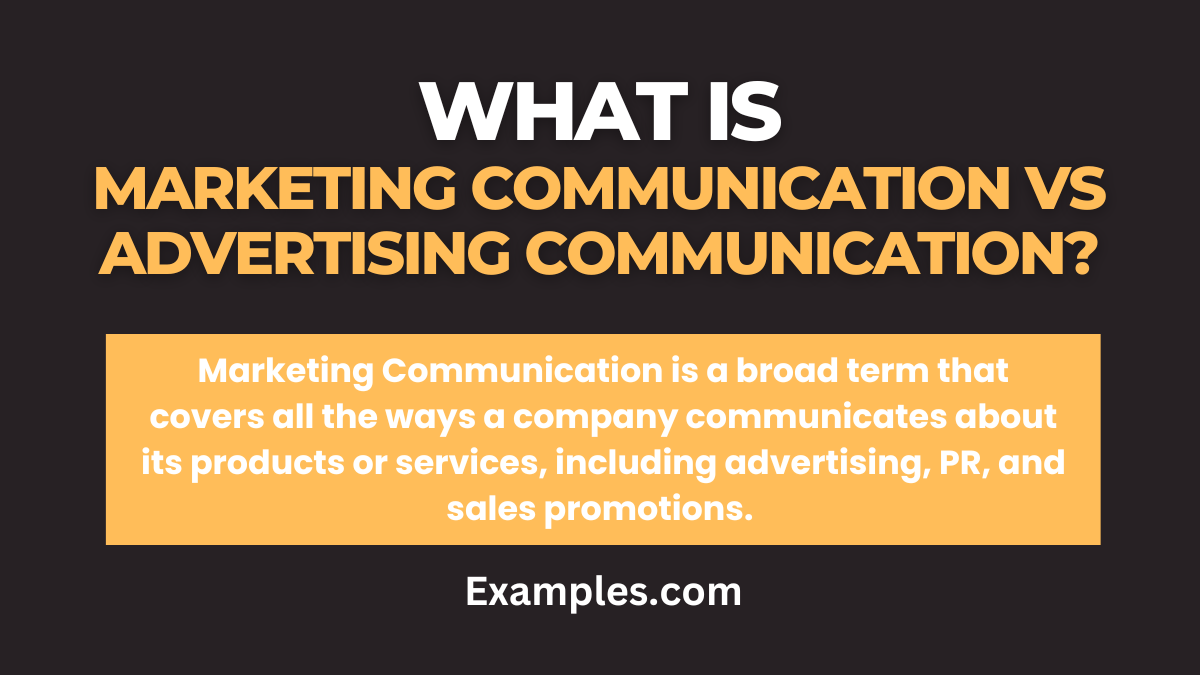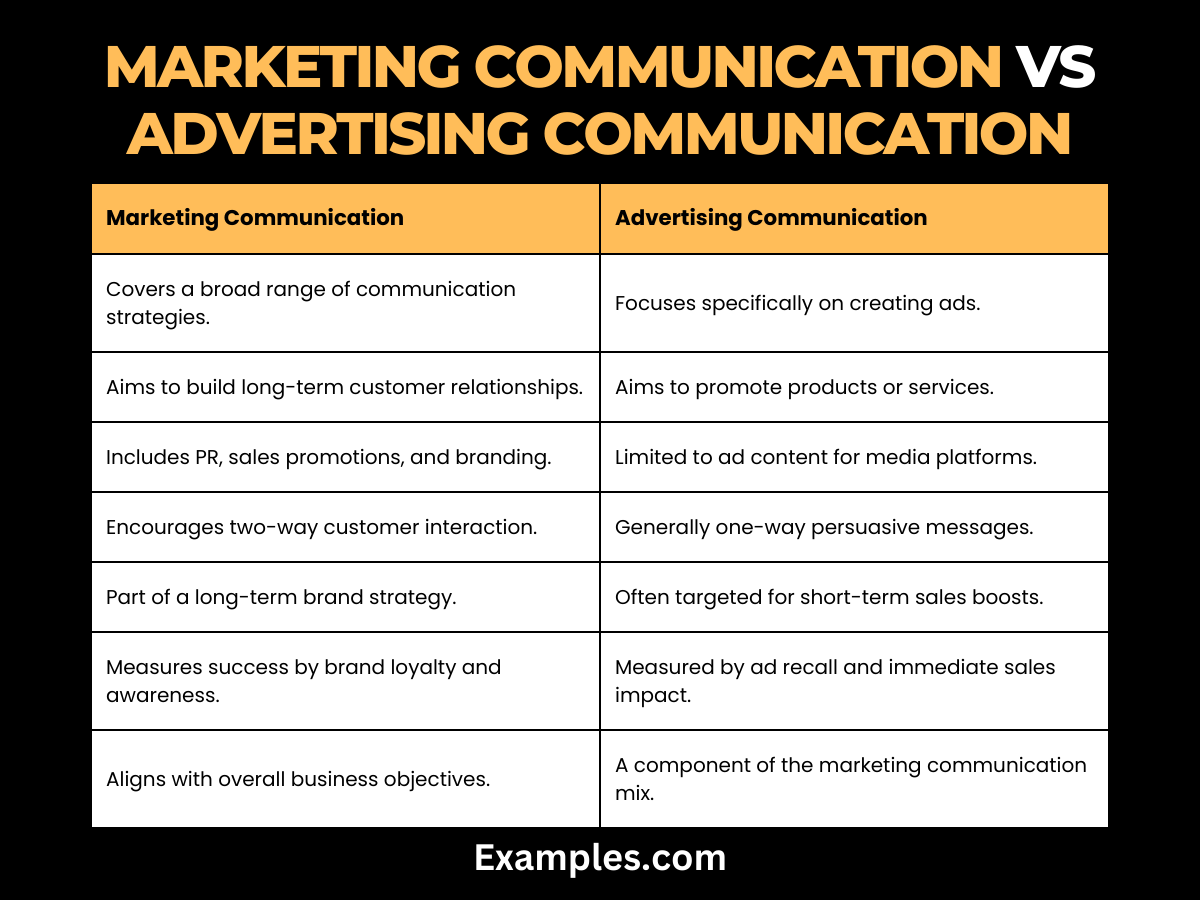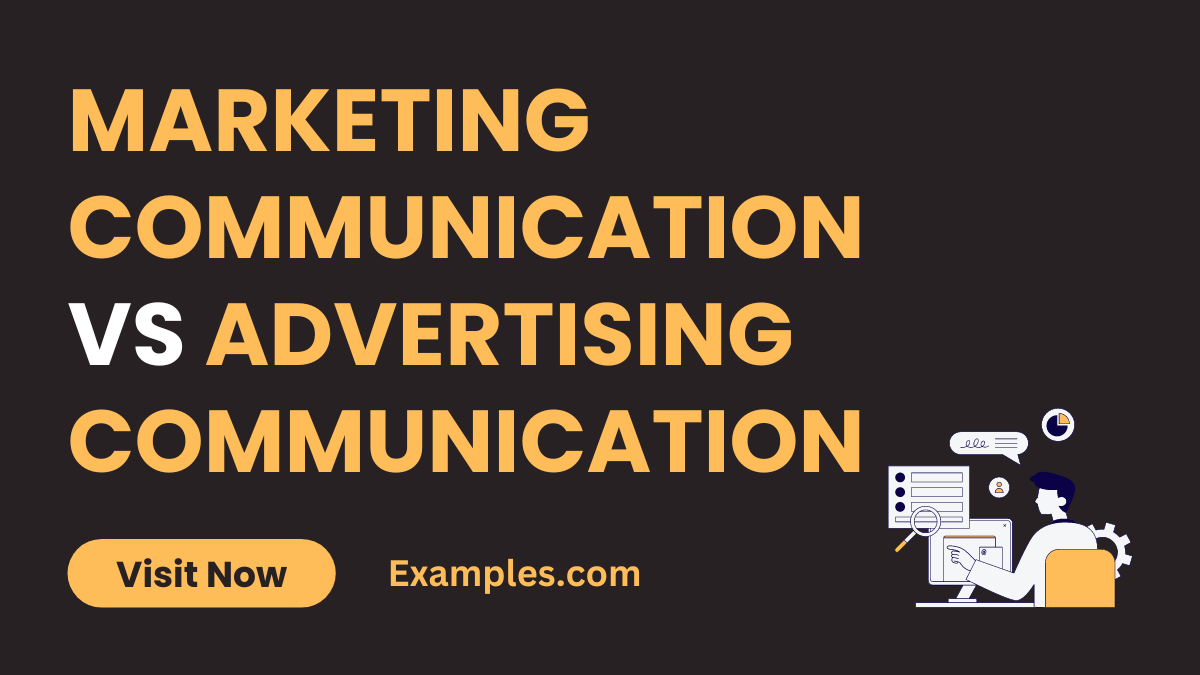Marketing Communication vs Advertising Communication
Embark on a comprehensive exploration of Marketing Communication vs Advertising Communication. This guide provides an in-depth look at these two pivotal aspects of business communication, enriched with various Marketing Communication Examples. Understand their unique roles, techniques, and impacts, and learn how to effectively apply them in your marketing strategy. Whether you’re a seasoned marketer or new to the field, this guide offers valuable insights, examples, and practical tips for mastering both marketing and advertising communications.
What is Marketing Communication vs Advertising Communication?

Marketing Communication is a broad term that covers all the ways a company communicates about its products or services, including advertising, PR, and sales promotions. Advertising Communication is a subset of this, focusing specifically on creating and spreading advertisements to promote products or services to a target audience.
Difference between Marketing Communication and Advertising Communication
Marketing Communication and Advertising Communication are distinct yet interconnected aspects of a company’s overall communication strategy. Below is a table highlighting their key differences:

| Marketing Communication | Advertising Communication |
|---|---|
| Encompasses a broader range of communication strategies beyond advertising. | Specifically focuses on creating and disseminating advertisements. |
| Aims to build and maintain relationships with customers, stakeholders, and the public. | Primarily aims to promote products, services, or brands to potential customers. |
| Includes various forms of communication like public relations, sales promotions, direct marketing, and branding. | Canters on crafting messages for various media platforms such as TV, radio, print, and online channels. |
| Involves two-way communication, allowing for customer feedback and interaction. | Generally one-way communication focused on persuading the audience. |
| Integrates different communication channels to deliver a cohesive brand message. | Utilizes creative and media buying strategies to place ads in targeted media outlets. |
| Often considered as a long-term strategy, focusing on building brand equity over time. | More focused on short-term goals like boosting immediate sales or market visibility. |
| Measures success through long-term indicators like brand loyalty, customer retention, and brand awareness. | Success is measured through immediate metrics such as ad recall, sales spikes, and click-through rates. |
| Marketing messages can vary, offering information, education, or promotional content. | Advertising messages are predominantly promotional, highlighting the benefits and features of the offering. |
| Encompasses a wider budget allocation, covering various communication activities. | Budget is often specifically allocated for creating and placing ads. |
| Plays a crucial role in the overall marketing strategy, aligning with business objectives. | Serves as a critical component within the marketing communication mix, focusing on creative message delivery. |
10 Examples of Marketing Communication
- Integrated Campaigns: Combine online and offline channels for a cohesive brand message.
Example: Align social media promotions with in-store events for a seamless brand experience. - Content Marketing: Create valuable content to engage and educate.
Example: Develop blog posts and videos that address customer pain points, showcasing expertise and building trust. - Email Marketing: Leverage personalized emails for targeted communication.
Example: Send tailored newsletters with exclusive offers, encouraging customer loyalty and conversions. - Influencer Collaborations: Partner with influencers for authentic endorsements.
Example: Collaborate with industry influencers to amplify product reviews, reaching new audiences. - Social Media Engagement: Foster meaningful interactions on social platforms.
Example: Host interactive polls and respond promptly to comments, building a vibrant online community. - Storytelling Techniques: Craft compelling narratives for brand resonance.
Example: Share brand origin stories through captivating visuals and narratives, forging emotional connections. - Search Engine Optimization (SEO): Optimize content for higher search visibility.
Example: Utilize relevant keywords in website content to enhance organic search rankings. - Visual Branding: Establish a consistent visual identity.
Example: Design eye-catching graphics and use a consistent colour palette for instant brand recognition. - Customer Testimonials: Showcase positive customer experiences.
Example: Feature testimonials on the website, reinforcing credibility and influencing potential buyers. - Event Marketing: Host or participate in events for direct engagement.
Example: Sponsor or organize industry events, providing opportunities for face-to-face networking and brand exposure.
10 Examples of Advertising Communication
- Emotional Appeal: Forge connections by tapping into emotions.
Example: A heart-warming commercial showcasing familial bonds to evoke sentiment and brand association. - Celebrity Endorsements: Leverage star power for credibility.
Example: Featuring a popular figure endorsing a product, enhancing trust and brand recognition. - Storytelling Techniques: Craft narratives that resonate.
Example: A compelling story unfolding in an ad, engaging viewers and conveying brand values. - Limited-Time Offers: Create urgency for immediate action.
Example: Boldly promoting a time-limited sale, driving customer urgency and swift responses. - Innovative Visuals: Capture attention with unique visuals.
Example: A visually striking ad showcasing product features in a memorable and creative way. - Interactive Content: Engage audiences with interactive elements.
Example: An ad inviting users to participate in a quiz or game, promoting active involvement. - Social Media Integration: Seamlessly blend into online platforms.
Example: Crafting ads that align with social media trends, ensuring relevance and share ability. - Customer Testimonials: Build trust through authentic experiences.
Example: Featuring customer testimonials expressing satisfaction and loyalty to instil confidence. - Humorous Elements: Infuse humour for a memorable impact.
Example: A light-hearted commercial evoking laughter, making the brand more relatable and memorable. - Influencer Collaborations: Partner with influencers for broader reach.
Example: Collaborating with influencers to authentically promote a product, leveraging their audience trust for brand endorsement.
Comparison Between Marketing Communication and Advertising Communication
In the intricate field of business communication, understanding the difference between Marketing Communication and Advertising Communication is essential. This guide aims to clarify these differences, offering a clear perspective on how each plays a unique role in the overall marketing strategy of a business.
- Scope and Application: Marketing Communication encompasses a broad range of communication activities aimed at promoting a brand or product. This includes Public Relations, Sales Promotion Communication in Marketing, Direct Communication in Marketing, and more. Advertising Communication, however, specifically refers to the creation and dissemination of advertisements across various media channels.
- Content and Message: The content in Marketing Communication is diverse, ranging from informational to persuasive and covering a wide spectrum of topics related to a company’s offerings. Advertising Communication, on the other hand, is more focused on persuasive content aimed at driving sales or brand recognition.
- Channels Used: Marketing Communication Channels are varied and include both traditional and digital platforms like social media, events, PR activities, and sales promotions. Advertising Communication predominantly utilizes specific channels like TV, radio, online platforms, and print media for ad placements.
- Target Audience: While both target potential customers, Marketing Communication often has a broader target that may include stakeholders like investors or employees. Advertising Communication is more customer-centric, focusing on reaching potential buyers.
- Measurement of Effectiveness: The effectiveness of Marketing Communication is measured in terms of overall brand perception, customer engagement, and long-term relationships. Advertising Communication’s success is more quantitatively measured through metrics like reach, impressions, and direct sales figures.
Relationship Between Marketing Communication and Advertising Communication
Though distinct, Marketing Communication and Advertising Communication are not isolated in practice; they have a synergistic relationship that enhances a company’s overall communication strategy.
- Complementary Roles: Advertising is a component of Marketing Communication. Effective advertising strategies are often developed within the broader framework of a company’s overall marketing communication plan.
- Consistent Brand Messaging: Consistency in messaging across both Marketing and Advertising Communications is crucial for building a strong, coherent brand identity.
- Strategic Integration: A well-integrated approach ensures that advertising campaigns support and align with broader marketing objectives, such as brand building or customer relationship management.
- Leveraging Each for Maximum Impact: Utilizing advertising to effectively convey specific product or service messages, within the broader context of the brand’s marketing communication, can lead to more impactful results.
- Feedback Loop: Insights gained from advertising campaigns can inform broader marketing communication strategies, helping to refine messaging, target audiences more effectively, and align with market trends.
In summary, this comprehensive guide illuminates the distinctions between marketing communication and advertising communication. Real-world examples illustrate their unique roles and applications. By understanding these nuances, businesses can craft more effective strategies, blending both elements to create cohesive campaigns. Embrace the insights shared to optimize your communication approach and achieve impactful results in the dynamic world of marketing.



